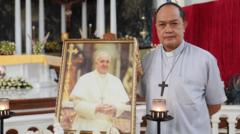**As 133 cardinals enter the Sistine Chapel for the first papal conclave in over a decade, the Catholic Church faces critical decisions and challenges that may influence the selection of the next pope.**
**Cardinals Gather for Historic Conclave to Choose New Pope Amid Uncertainty**

**Cardinals Gather for Historic Conclave to Choose New Pope Amid Uncertainty**
**Intense Seclusion Surrounds Papal Voting Process as World's Attention Turns to Vatican**
The moment is solemn as the 133 cardinals clad in red begin their procession into the Sistine Chapel, marking the commencement of a papal conclave — a historic event that has not occurred for more than a decade. The death of Pope Francis just over two weeks ago catalyzed this gathering, which is as much a ceremonial tradition as it is a pivotal decision-making venture involving the future of 1.4 billion Roman Catholics worldwide.
On this day, the chapel's door has been sealed, shrouding its inhabitants in a world away from contemporary distractions like phones and the internet, focusing solely on their mission to elect a new pope. The Conclave promises to be complex, given the many cardinals appointed by Francis, many of whom are now meeting for the first time, thus introducing a potential flux of new alliances and factions which could affect the voting dynamics.
A Mass at St. Peter's Basilica served as the last opportunity for the cardinals to engage in public prayer before taking their oaths inside the chapel. A controversial time for the Church, challenges range from its financial strain to historical reckoning in light of past sexual abuse scandals, all of which will weigh on the minds of the cardinals as they approach their decision.
As the conclave unfolds, the intricate voting process begins. Cardinals will proceed to cast their votes by secret ballot multiple times daily until a consensus is reached. Speculations regarding who will ascend to the papacy are rampant, with Cardinal Pietro Parolin, Francis's former second-in-command, making headlines as a key contender alongside others such as Cardinal Luis Antonio Tagle and Cardinal Matteo Zuppi.
Experts are keenly observing what this conclave will decide: whether to continue expanding the progressive approach initiated by Francis or to lean towards more conservative choices. With rampant discussions surrounding the future course of the Church, this conclave stands poised to redefine its place in a rapidly shifting religious and societal landscape.
As murmurs of potential successors swirl, the countdown for the emergence of "white smoke" signaling a new pontiff begins. Each vote, filled with weighty responsibility under the shadow of Michelangelo's stunning creations, echoes through the very heart of Roman Catholicism, a testimony to both rich history and pressing contemporary challenges.
With collective prayer guiding their choices, the cardinal electors remind us that the sanctity of each vote reflects more than personal preferences — they embody the hopes and aspirations of a worldwide faith community seeking direction. The outcome of this conclave holds the power to shape the Catholic Church for generations to come.
On this day, the chapel's door has been sealed, shrouding its inhabitants in a world away from contemporary distractions like phones and the internet, focusing solely on their mission to elect a new pope. The Conclave promises to be complex, given the many cardinals appointed by Francis, many of whom are now meeting for the first time, thus introducing a potential flux of new alliances and factions which could affect the voting dynamics.
A Mass at St. Peter's Basilica served as the last opportunity for the cardinals to engage in public prayer before taking their oaths inside the chapel. A controversial time for the Church, challenges range from its financial strain to historical reckoning in light of past sexual abuse scandals, all of which will weigh on the minds of the cardinals as they approach their decision.
As the conclave unfolds, the intricate voting process begins. Cardinals will proceed to cast their votes by secret ballot multiple times daily until a consensus is reached. Speculations regarding who will ascend to the papacy are rampant, with Cardinal Pietro Parolin, Francis's former second-in-command, making headlines as a key contender alongside others such as Cardinal Luis Antonio Tagle and Cardinal Matteo Zuppi.
Experts are keenly observing what this conclave will decide: whether to continue expanding the progressive approach initiated by Francis or to lean towards more conservative choices. With rampant discussions surrounding the future course of the Church, this conclave stands poised to redefine its place in a rapidly shifting religious and societal landscape.
As murmurs of potential successors swirl, the countdown for the emergence of "white smoke" signaling a new pontiff begins. Each vote, filled with weighty responsibility under the shadow of Michelangelo's stunning creations, echoes through the very heart of Roman Catholicism, a testimony to both rich history and pressing contemporary challenges.
With collective prayer guiding their choices, the cardinal electors remind us that the sanctity of each vote reflects more than personal preferences — they embody the hopes and aspirations of a worldwide faith community seeking direction. The outcome of this conclave holds the power to shape the Catholic Church for generations to come.





















